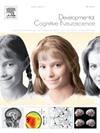错误处理的神经标记与任务表现有关,但与青少年和成年初期的物质相关风险和问题以及外化问题无关。
IF 4.9
2区 医学
Q1 NEUROSCIENCES
引用次数: 0
摘要
发现错误并相应地调整行为构成了认知的一个组成部分。先前的研究已经将错误处理的神经关联(例如,错误相关的消极(ERN)和错误相关的积极(Pe))与任务表现和更广泛的行为结构联系起来,但很少有研究调查这些关联如何在青少年中表现出来。在这项研究中,我们采用停止信号任务,研究了青少年/初成成人样本(N = 143,年龄= 18.0,范围11-25岁)的神经错误处理标记及其行为关联。采用自举重采样进行线性回归,以探索ERN/Pe峰值振幅与潜伏期、停止准确性、停止信号反应时间(SSRT)、错误后减慢以及自我报告的物质相关风险和问题以及外化问题之间的关系。在调整年龄和性别后,较小的额中央Pe振幅和较晚的Pe潜伏期与较长的SSRT相关,而较晚的Pe潜伏期与较低的停止准确性相关。这可能表明,被认为反映有意识错误处理的Pe比反映潜意识错误处理的ERN更能反映反应抑制任务的任务表现。经过多次测试校正后,ERN/Pe参数与物质相关或外化问题之间没有关联,也没有发现这些关联的年龄相互作用。本文章由计算机程序翻译,如有差异,请以英文原文为准。
Neural markers of error processing relate to task performance, but not to substance-related risks and problems and externalizing problems in adolescence and emerging adulthood
Detecting errors and adapting behavior accordingly constitutes an integral aspect of cognition. Previous studies have linked neural correlates of error processing (e.g., error-related negativity (ERN) and error-related positivity (Pe)) to task performance and broader behavioral constructs, but few studies examined how these associations manifest in adolescence. In this study, we examined neural error processing markers and their behavioral associations in an adolescent/emerging adult sample (N = 143, Mage = 18.0 years, range 11–25 years), employing a stop-signal task. Linear regressions were conducted using bootstrap resampling to explore associations between ERN/Pe peak amplitudes and latencies, stop accuracy, stop-signal reaction time (SSRT), and post-error slowing, as well as self-reported substance-related risks and problems and externalizing problems. After adjusting for age and sex, smaller frontocentral Pe amplitude and later Pe latency were associated with longer SSRT, and later Pe latency was associated with lower stop accuracy. This might indicate that the Pe, which is thought to reflect conscious error processing, reflects task performance on a response inhibition task better than the ERN, which reflects subconscious error processing. After correcting for multiple testing, there were no associations between ERN/Pe parameters and substance-related or externalizing problems, and no age interactions for these associations were detected.
求助全文
通过发布文献求助,成功后即可免费获取论文全文。
去求助
来源期刊

Developmental Cognitive Neuroscience
NEUROSCIENCES-
CiteScore
7.60
自引率
10.60%
发文量
124
审稿时长
6-12 weeks
期刊介绍:
The journal publishes theoretical and research papers on cognitive brain development, from infancy through childhood and adolescence and into adulthood. It covers neurocognitive development and neurocognitive processing in both typical and atypical development, including social and affective aspects. Appropriate methodologies for the journal include, but are not limited to, functional neuroimaging (fMRI and MEG), electrophysiology (EEG and ERP), NIRS and transcranial magnetic stimulation, as well as other basic neuroscience approaches using cellular and animal models that directly address cognitive brain development, patient studies, case studies, post-mortem studies and pharmacological studies.
 求助内容:
求助内容: 应助结果提醒方式:
应助结果提醒方式:


